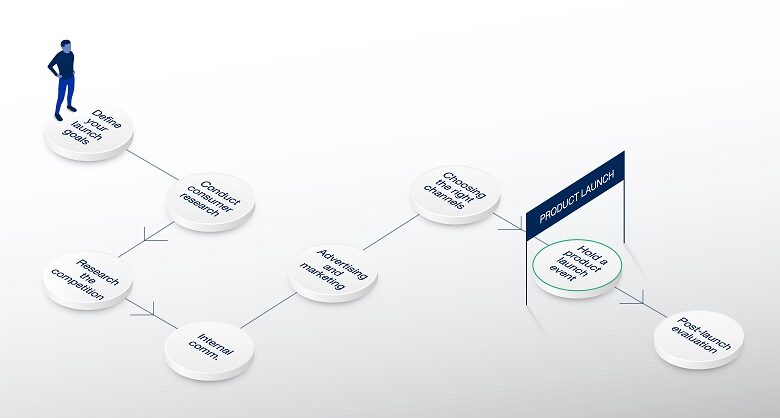Strategies for Successful Product Launches

Launching a new product into the market is an exhilarating yet challenging endeavor. Success requires a combination of meticulous planning, effective execution, and a deep understanding of your target audience. In this article, we will explore strategies for successful product launches, offering insights into key considerations, best practices, and the crucial role of a well-crafted go-to-market strategy.
Thorough Market Research
A successful product launch begins with a foundation of thorough market research. Understand the needs, preferences, and pain points of your target audience. Analyze the competitive landscape to identify gaps or opportunities your product can address. This information forms the basis for crafting a product that resonates with the market and informs your overall launch strategy.
Create a Compelling Value Proposition
Clearly articulate the value your product brings to the market. What problem does it solve, and how does it benefit the consumer? Your value proposition should be concise, compelling, and differentiate your product from competitors. A well-defined value proposition serves as the cornerstone of your messaging throughout the launch.
Identify and Understand Your Target Audience
Knowing your audience is key to tailoring your messaging and outreach efforts. Create detailed buyer personas that encompass demographics, preferences, and behavior patterns. Understanding your target audience enables you to communicate in a way that resonates with them, increasing the likelihood of a positive reception to your product.
Strategic Branding and Positioning
Develop a strong brand identity that aligns with your product and resonates with your target audience. Effective branding goes beyond a memorable logo; it includes the tone of your messaging, visual elements, and the overall perception you want to create. Position your product in a way that emphasizes its unique features and benefits within the market landscape.
Build Anticipation with Teasers and Pre-launch Marketing
Generate excitement around your product by strategically using teasers and pre-launch marketing. Leverage social media, email campaigns, and other channels to create anticipation. Tease key features, share behind-the-scenes glimpses, and offer exclusive sneak peeks. This not only builds interest but also establishes a sense of community around your product.
Leverage Influencer Marketing
Identify influencers in your industry or niche who align with your brand and target audience. Engage them to create content or endorse your product. Influencers can significantly amplify your reach and lend credibility to your product. Establishing relationships with influencers should be part of your broader marketing strategy.
Forge Partnerships for Extended Reach
Collaborate with strategic partners to extend the reach of your product launch. Identify partners whose audience aligns with your target market and explore mutually beneficial collaborations. This could involve joint marketing efforts, co-branded content, or even bundling products or services. By leveraging the existing audience of your partners, you amplify your reach and tap into new customer segments. Strategic partnerships add credibility to your launch and create a network effect, increasing the overall impact of your product in the market.
Provide Exclusive Pre-launch Access
Reward your most engaged audience members with exclusive pre-launch access. This could be in the form of a limited beta release, early access codes, or special promotions. Offering exclusivity not only makes your audience feel valued but also generates positive word-of-mouth, setting the stage for a successful launch.
Craft a Comprehensive Go-to-Market Strategy
A well-crafted go-to-market strategy is pivotal for a successful product launch. This strategy should encompass the entire customer journey, from awareness and consideration to purchase and post-purchase engagement. Define your distribution channels, pricing strategy, and sales approach. The go-to-market strategy serves as a roadmap for all your launch activities, ensuring a cohesive and effective campaign.
Utilize Multi-Channel Marketing
Implement a multi-channel marketing approach to reach your audience wherever they are. This includes a mix of digital marketing, social media, traditional advertising, and content marketing. Tailor your messaging for each channel while maintaining consistency in the overall narrative. A diverse marketing strategy increases your product’s visibility and accessibility.
Invest in High-Quality Content Marketing
Develop a content marketing strategy that educates and engages your audience. Create blog posts, videos, infographics, and other content that highlights the value of your product. Share customer testimonials, use cases, and success stories to build credibility. A robust content marketing strategy contributes to organic visibility and positions your product as a solution to your audience’s needs.
Establish a Clear Launch Timeline
Plan your launch timeline meticulously. Establish specific milestones, deadlines, and tasks leading up to the launch date. This ensures that every aspect of the launch, from marketing campaigns to product availability, is well-coordinated. A clear timeline also allows for effective communication and collaboration among cross-functional teams involved in the launch.
Monitor and Adapt with Analytics
Implement analytics tools to track the performance of your launch activities. Monitor key metrics such as website traffic, conversion rates, and social media engagement. Analyze the data to gain insights into what is working well and where adjustments are needed. This continuous monitoring and adaptation process is crucial for optimizing your strategy in real-time.
Maximize Customer Engagement with Interactive Launch Events
Elevate your product launch by organizing interactive launch events that directly involve your audience. Virtual or physical events, such as webinars, live demonstrations, or interactive Q&A sessions, provide an opportunity for direct engagement. These events not only allow potential customers to experience your product in real-time but also foster a sense of community around your brand. Incorporate gamification elements or exclusive promotions during these events to enhance participation and leave a lasting impression on attendees.
Engage Your Audience Post-Launch
The launch date is not the endpoint; it’s the beginning of an ongoing relationship with your customers. Continue to engage your audience post-launch through email campaigns, social media interactions, and customer support. Encourage user-generated content, gather feedback, and iterate on your product based on customer insights. This sustained engagement contributes to long-term success and customer loyalty.
Gather and Act on Customer Feedback
Actively seek and collect customer feedback after the launch. This valuable input can highlight areas for improvement, identify potential issues, and guide future product iterations. Demonstrating responsiveness to customer feedback also builds trust and reinforces your commitment to delivering a product that meets or exceeds expectations.
Conclusion
In conclusion, a successful product launch is a multifaceted undertaking that requires strategic planning, effective communication, and adaptability. By integrating these strategies into your launch plan, you can create a compelling narrative, generate anticipation, and build lasting relationships with your audience. A well-defined go-to-market strategy serves as the linchpin, ensuring that all elements align seamlessly for a successful and impactful product launch.



